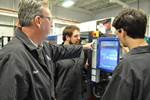RJG Training Facility Adds Bole Machine
RJG’s Gibsonville, N.C. training site has added a 110-ton servodriven hydraulic Bole consignment machine.
Injection molding technology and training provider RJG Inc. (Traverse City, Mich.) announced the addition of a Bole 100 EKS C340 servodriven hydraulic injection molding machine to its training facility in Gibsonville, N.C. The 3000-ft2 training facility opened in 2016 with seven injection molding machines and a classroom with seating for 22 students.
The consignment Bole press features a 3.6-oz barrel and 45,432 ppsi of available injection pressure. RJG notes that the servodriven hydraulic system offers high efficiency and low energy consumption. The press also features Bole’s patented Central Clamping System (CCS) technology and floating tiebar design. Bole, which was founded in 1998 is a unit of Chenglu Group—a subsidiary of Ningbo Shuangma Machinery Industry Co. Ltd. The EK-S series was introduced in 2018.
Marty Key, Consultant/Trainer at RJG, said the machine will be used in various training courses, including RJG’s Essentials, Fundamentals of Systematic Injection Molding; the Decoupled Molding Workshop; and Master Molder I and II courses.

RJG’s Gibsonville, N.C. training facility has added a new 110-ton servohydraulic injection molding machine from Bole.
Related Content
-
Optimizing Pack & Hold Times for Hot-Runner & Valve-Gated Molds
Using scientific procedures will help you put an end to all that time-consuming trial and error. Part 1 of 2.
-
Is There a More Accurate Means to Calculate Tonnage?
Molders have long used the projected area of the parts and runner to guesstimate how much tonnage is required to mold a part without flash, but there’s a more precise methodology.
-
Understanding the Effect of Pressure Losses on Injection Molded Parts
The compressibility of plastics as a class of materials means the pressure punched into the machine control and the pressure the melt experiences at the end of fill within the mold will be very different. What does this difference mean for process consistency and part quality?


